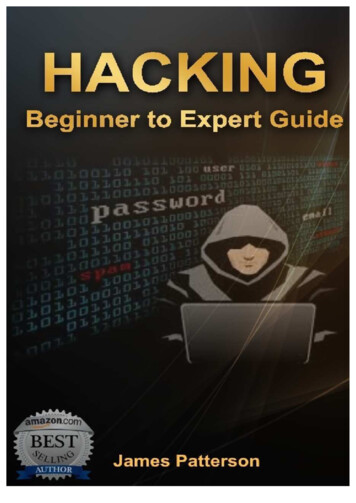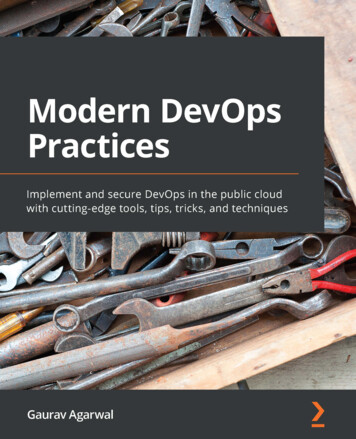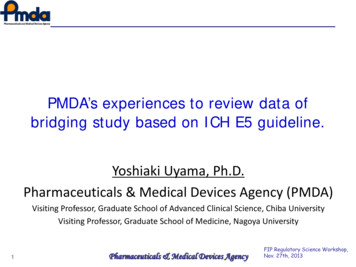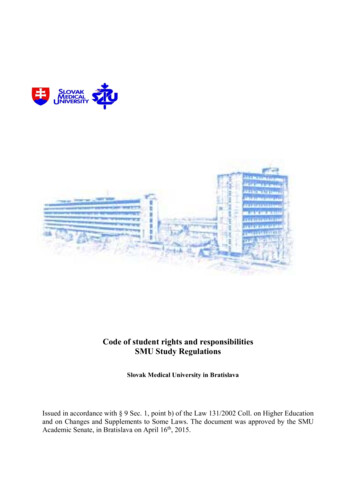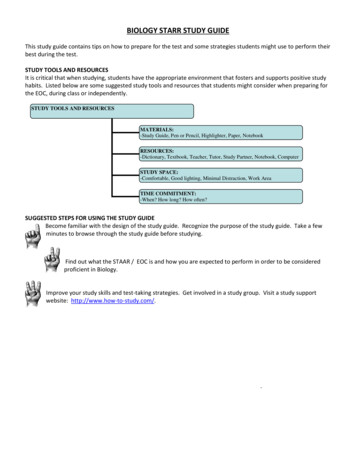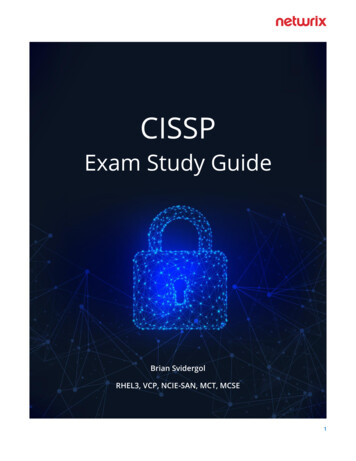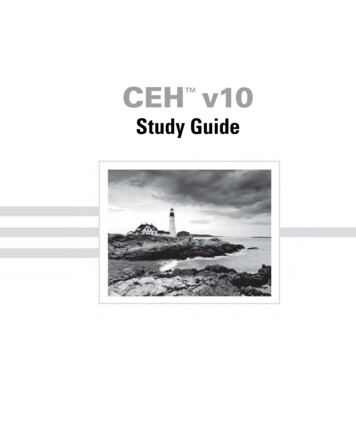
Transcription
CEH v10TMStudy Guide
CEH v10TMCertified Ethical HackerStudy GuideRic Messier,CEH, GCIH, GSEC, CISSP
Development Editor: Kim WimpsettTechnical Editors: Russ Christy and Megan DaudelinSenior Production Editor: Christine O’ConnorCopy Editor: Judy FlynnEditorial Manager: Pete GaughanProduction Manager: Kathleen WisorAssociate Publisher: Jim MinatelBook Designers: Judy Fung and Bill GibsonProofreader: Louise Watson, Word One New YorkIndexer: Johnna VanHoose DinseProject Coordinator, Cover: Brent SavageCover Designer: WileyCover Image: Getty Images Inc. / Jeremy WoodhouseCopyright 2019 by John Wiley & Sons, Inc., Indianapolis, IndianaPublished simultaneously in CanadaISBN: 978-1-119-53319-1ISBN: 978-1-119-53325-2 (ebk.)ISBN: 978-1-119-53326-9 (ebk.)Manufactured in the United States of AmericaNo part of this publication may be reproduced, stored in a retrieval system or transmitted in any form orby any means, electronic, mechanical, photocopying, recording, scanning or otherwise, except as permitted under Sections 107 or 108 of the 1976 United States Copyright Act, without either the prior writtenpermission of the Publisher, or authorization through payment of the appropriate per-copy fee to theCopyright Clearance Center, 222 Rosewood Drive, Danvers, MA 01923, (978) 750-8400, fax (978)646-8600. Requests to the Publisher for permission should be addressed to the Permissions Department,John Wiley & Sons, Inc., 111 River Street, Hoboken, NJ 07030, (201) 748-6011, fax (201) 748-6008, oronline at http://www.wiley.com/go/permissions.Limit of Liability/Disclaimer of Warranty: The publisher and the author make no representations or warranties with respect to the accuracy or completeness of the contents of this work and specifically disclaimall warranties, including without limitation warranties of fitness for a particular purpose. No warrantymay be created or extended by sales or promotional materials. The advice and strategies contained hereinmay not be suitable for every situation. This work is sold with the understanding that the publisher is notengaged in rendering legal, accounting, or other professional services. If professional assistance is required,the services of a competent professional person should be sought. Neither the publisher nor the authorshall be liable for damages arising herefrom. The fact that an organization or Web site is referred to in thiswork as a citation and/or a potential source of further information does not mean that the author or thepublisher endorses the information the organization or Web site may provide or recommendations it maymake. Further, readers should be aware that Internet Web sites listed in this work may have changed ordisappeared between when this work was written and when it is read.For general information on our other products and services or to obtain technical support, please contactour Customer Care Department within the U.S. at (877) 762-2974, outside the U.S. at (317) 572-3993 orfax (317) 572-4002.Wiley publishes in a variety of print and electronic formats and by print-on-demand. Some materialincluded with standard print versions of this book may not be included in e-books or in print-on-demand.If this book refers to media such as a CD or DVD that is not included in the version you purchased, youmay download this material at http://booksupport.wiley.com. For more information about Wileyproducts, visit www.wiley.com.Library of Congress Control Number: 2019940400TRADEMARKS: Wiley, the Wiley logo, and the Sybex logo are trademarks or registered trademarks ofJohn Wiley & Sons, Inc. and/or its affiliates, in the United States and other countries, and may not be usedwithout written permission. CEH is a trademark of EC-Council. All other trademarks are the property oftheir respective owners. John Wiley & Sons, Inc. is not associated with any product or vendor mentionedin this book.10 9 8 7 6 5 4 3 2 1
About the AuthorRic Messier, GCIH, GSEC, CEH, CISSP, MS, has entirely too many letters after his name,as though he spends time gathering up strays that follow him home at the end of the day.His interest in information security began in high school but was cemented when he wasa freshman at the University of Maine, Orono, when he took advantage of a vulnerabilityin a jailed environment to break out of the jail and gain elevated privileges on an IBMmainframe in the early 1980s. His first experience with Unix was in the mid-1980s andwith Linux in the mid-1990s. Ric is an author, trainer, educator, and security professionalwith multiple decades of experience. He is currently a Senior Information SecurityConsultant with FireEye Mandiant and occasionally teaches courses at Harvard Universityand the University of Colorado Boulder.
Contents at a GlanceIntroductionxviiAssessment TestxxivChapter 1Ethical Hacking1Chapter 2Networking Foundations9Chapter 3Security Foundations49Chapter 4Footprinting and Reconnaissance83Chapter 5Scanning Networks135Chapter 6Enumeration193Chapter 7System Hacking233Chapter 8Malware279Chapter 9Sniffing321Chapter 10Social Engineering357Chapter 11Wireless Security387Chapter 12Attack and Defense419Chapter 13Cryptography447Chapter 14Security Architecture and Design475AppendixAnswers to Review Questions501Index531
ContentsIntroductionxviiAssessment TestxxivChapterChapter12Ethical Hacking1Overview of EthicsOverview of Ethical HackingMethodology of Ethical HackingReconnaissance and FootprintingScanning and EnumerationGaining AccessMaintaining AccessCovering TracksSummary245667788Networking Foundations9Communications Models11Open Systems Interconnection12TCP/IP Architecture15Topologies16Bus Network16Star Network17Ring Network18Mesh Network19Hybrid20Physical Networking21Addressing21Switching22IP 23Headers23Addressing25Subnets2628TCPUDP31Internet Control Message Protocol3233Network ArchitecturesNetwork Types34Isolation35Remote Access36
xContentsChapterChapter34Cloud ComputingStorage as a ServiceInfrastructure as a ServicePlatform as a ServiceSoftware as a ServiceInternet of ThingsSummaryReview Questions3637394042434446Security Foundations49The TriadConfidentialityIntegrityAvailabilityParkerian HexadRiskPolicies, Standards, and ProceduresSecurity PoliciesSecurity StandardsProceduresGuidelinesSecurity TechnologyFirewallsIntrusion Detection SystemsIntrusion Prevention SystemsSecurity Information and Event ManagementBeing PreparedDefense in DepthDefense in BreadthLoggingAuditingSummaryReview 67879Footprinting and Reconnaissance83Open-Source IntelligenceCompaniesPeopleSocial NetworkingDomain Name SystemName LookupsZone TransfersPassive Reconnaissance85859397108109115117
ContentsChapter5Website IntelligenceTechnology IntelligenceGoogle HackingInternet of Things (IoT)SummaryReview Questions120124125126128130Scanning Networks135Ping SweepsUsing fpingUsing MegaPingPort ScanningNmapmasscanMegaPingVulnerability ScanningOpenVASNessusPacket Crafting and ManipulationhpingpackETHfragrouteEvasion TechniquesSummaryReview 77178180183185187189Enumeration193Service EnumerationRemote Procedure CallsSunRPCRemote Method InvocationServer Message BlockBuilt-In UtilitiesNmap ScriptsMetasploitOther UtilitiesSimple Network Management ProtocolSimple Mail Transfer ProtocolWeb-Based EnumerationSummaryReview 8
xiiChapterChapterChapterContents789System Hacking233Searching for ExploitsSystem CompromiseMetasploit ModulesExploit-DBGathering PasswordsPassword CrackingJohn the RipperRainbow TablesClient-Side VulnerabilitiesPost ExploitationPrivilege EscalationPivotingPersistenceCovering TracksSummaryReview 5272274Malware279Malware TypesVirusWormTrojanBotnetRansomwareDropperMalware AnalysisStatic AnalysisDynamic AnalysisCreating MalwareWriting Your OwnUsing MetasploitMalware InfrastructureAntivirus SolutionsSummaryReview 1314314316Sniffing321Packet CapturetcpdumptsharkWiresharkBerkeley Packet Filter (BPF)Port Mirroring/Spanning322323329331335336
ContentsChapter10Packet AnalysisSpoofing AttacksARP SpoofingDNS SpoofingsslstripSummaryReview Questions337342342346348350352Social Engineering357Social EngineeringPretextingSocial Engineering VectorsPhysical Social EngineeringBadge AccessMan TrapsBiometricsPhone CallsBaitingPhishing AttacksWebsite AttacksCloningRogue AttacksWireless Social EngineeringAutomating Social EngineeringSummaryReview QuestionsChapter11xiiiWireless SecurityWi-FiWi-Fi Network TypesWi-Fi AuthenticationWi-Fi EncryptionBring Your Own Device (BYOD)Wi-Fi ebuggingMobile DevicesMobile Device AttacksSummaryReview 12414416
xivChapterChapterContents1213Attack and Defense419Web Application AttacksXML External Entity ProcessingCross-Site Scripting (XSS)SQL InjectionCommand InjectionDenial of Service AttacksBandwidth AttacksSlow AttacksLegacyApplication ExploitationBuffer OverflowHeap SprayingLateral MovementDefense in Depth/Defense in BreadthDefensible Network ArchitectureSummaryReview 8440441443Cryptography447Basic EncryptionSubstitution CiphersDiffie-HellmanSymmetric Key CryptographyData Encryption Standard (DES)Advanced Encryption Standard (AES)Asymmetric Key CryptographyHybrid CryptosystemNon-RepudiationElliptic Curve CryptographyCertificate Authorities and Key ManagementCertificate AuthorityTrusted Third PartySelf-Signed CertificatesCryptographic HashingPGP and S/MIMESummaryReview 3465467469471
ContentsChapterAppendix14Security Architecture and Design475Data ClassificationSecurity ModelsState MachineBibaBell-LaPadulaClark-Wilson Integrity ModelApplication Architecturen-tier Application DesignService-Oriented ArchitectureCloud-Based ApplicationsDatabase ConsiderationsSecurity ArchitectureSummaryReview 7Answers to Review QuestionsChapter 2: Networking FoundationsChapter 3: Security FoundationsChapter 4: Footprinting and ReconnaissanceChapter 5: Scanning NetworksChapter 6: EnumerationChapter 7: System HackingChapter 8: MalwareChapter 9: SniffingChapter 10: Social EngineeringChapter 11: Wireless SecurityChapter 12: Attack and DefenseChapter 13: CryptographyChapter 14: Security Architecture and 26528531
IntroductionYou’re thinking about becoming a Certified Ethical Hacker (CEH). No matter whatvariation of security testing you are performing—ethical hacking, penetration testing, redteaming or application assessment—the skills and knowledge necessary to achieve this certification are in demand. Even the idea of security testing and ethical hacking is evolving asbusinesses and organizations begin to have a better understanding of the adversaries theyare facing. It’s no longer the so-called script kiddies that businesses felt they were fendingoff for so long. Today’s adversary is organized, well-funded, and determined. This meanstesting requires different tactics.Depending on who you are listening to, 80–90 percent of attacks today use social engineering. The old technique of looking for technical vulnerabilities in network services issimply not how attackers are getting into networks. Networks that are focused on applyinga defense in depth approach, hardening the outside, may end up being susceptible to attacksfrom the inside, which is what happens when desktop systems are compromised. The skillsneeded to identify vulnerabilities and recommend remediations are evolving, along with thetactics and techniques used by attackers.This book is written to help you understand the breadth of content you will needto know to obtain the CEH certification. You will find a lot of concepts to provideyou a foundation that can be applied to the skills required for the certification. Whileyou can read this book cover to cover, for a substantial chunk of the subjects gettinghands-on experience is essential. The concepts are often demonstrated through the useof tools. Following along with these demonstrations and using the tools yourself willhelp you understand the tools and how to use them. Many of the demonstrations aredone in Kali Linux, though many of the tools have Windows analogs if you are morecomfortable there.We can’t get through this without talking about ethics, though you will find it mentioned several places throughout the book. This is serious, and not only because it’s a hugepart of the basis for the certification. It’s also essential for protecting yourself and thepeople you are working for. The very short version of it is do not do anything that wouldcause damage to systems or your employer. There is much more to it than that, which you’llread more about in Chapter 1 as a starting point. It’s necessary to start wrapping your headaround the ethics involved in this exam and profession. You will have to sign an agreementas part of achieving your certification.At the end of each chapter, you will find a set of questions. This will help you to demonstrate to yourself that you understand the content. Most of the questions are multiplechoice, which is the question format used for the CEH exam. These questions, alongwith the hands-on experience you take advantage of, will be good preparation for takingthe exam.
xviiiIntroductionWhat Is a CEH?The Certified Ethical Hacker (CEH) exam is to validate that those holding the certificationunderstand the broad range of subject matter that is required for someone to be an effectiveethical hacker. The reality is that most days, if you are paying attention to the news, youwill see a news story about a company that has been compromised and had data stolen, agovernment that has been attacked, or even enormous denial of service attacks, making itdifficult for users to gain access to business resources.The CEH is a certification that recognizes the importance of identifying security issuesin order to get them remediated. This is one way companies can protect themselves againstattacks—by getting there before the attackers do. It requires someone who knows how tofollow techniques that attackers would normally use. Just running scans using automatedtools is insufficient because as good as security scanners may be, they will identify falsepositives—cases where the scanner indicates an issue that isn’t really an issue. Additionally,they will miss a lot of vulnerabilities—false negatives—for a variety of reasons, includingthe fact that the vulnerability or attack may not be known.Because companies need to understand where they are vulnerable to attack, they needpeople who are able to identify those vulnerabilities, which can be very complex. Scannersare a good start, but being able to find holes in complex networks can take the creativeintelligence that humans offer. This is why we need ethical hackers. These are people whocan take extensive knowledge of a broad range of technical subjects and use it to identifyvulnerabilities that can be exploited.The important part of that two-word phrase, by the way, is “ethical.” Companies haveprotections in place because they have resources they don’t want stolen or damaged. Whenthey bring in someone who is looking for vulnerabilities to exploit, they need to be certainthat nothing will be stolen or damaged. They also need to be certain that anything thatmay be seen or reviewed isn’t shared with anyone else. This is especially true when it comesto any vulnerabilities that have been identified.The CEH exam, then, has a dual purpose. It not only tests deeply technical knowledgebut also binds anyone who is a certification holder to a code of conduct. Not only will yoube expected to know the content and expectations of that code of conduct, you will beexpected to live by that code. When companies hire or contract to people who have theirCEH certification, they can be assured they have brought on someone with discretion whocan keep their secrets and provide them with professional service in order to help improvetheir security posture and keep their important resources protected.The Subject MatterIf you were to take the CEH v10 training, you would have to go through the followingmodules: Introduction to Ethical Hacking Footprinting and Reconnaissance
Introduction Scanning Networks Enumeration Vulnerability Analysis System Hacking Malware Threats Sniffing Social Engineering Denial of Service Session Hijacking Evading IDSs, Firewalls, and Honeypots Hacking Web Servers Hacking Web Applications SQL Injection Hacking Wireless Networks Hacking Mobile Platforms IoT Hacking Cloud Computing CryptographyxixAs you can see, the range of subjects is very broad. Beyond knowing the concepts associated with these topics, you will be expected to know about various tools that may be usedto perform the actions associated with the concepts you are learning. You will need toknow tools like nmap for port scanning, for example. You may need to know proxy-basedweb application attack tools. For wireless network attacks, you may need to know aboutthe aircrack-ng suite of tools. For every module listed above, there are potentially dozens oftools that may be used.The subject matter of the CEH exam is very technical. This is not a field in which youcan get by with theoretical knowledge. You will need to have had experience with themethods and tools that are covered within the subject matter for the CEH exam. What youmay also have noticed here is that the modules all fall within the different stages mentionedearlier. While you may not necessarily be asked for a specific methodology, you will findthat the contents of the exam do generally follow the methodology that the EC-Councilbelieves to be a standard approach.About the ExamThe CEH exam has much the same parameters as other professional certification exams.You will take a computerized, proctored exam. You will have 4 hours to complete125 questions. That means you will have, on average, roughly 2 minutes per question.
xxIntroductionThe questions are all multiple choice. The exam can be taken through the ECC ExamCenter or at a Pearson VUE center.Should you wish to take your certification even further, you could go after the CEHPractical exam. For this exam you must perform an actual penetration test and write areport at the end of it. This demonstrates that in addition to knowing the body of materialcovered by the exam, you can put that knowledge to use in a practical way. You will beexpected to know how to compromise systems and identify vulnerabilities.In order to pass the exam, you will have to correctly answer questions, though theactual number of questions you have to answer correctly will vary. The passing grade variesdepending on the difficulty of the questions asked. The harder the questions that are askedout of the complete pool of questions, the fewer questions you need to get right to pass theexam. If you get easier questions, you will need to get more of the questions right to pass.There are some sources of information that will tell you that you need to get 70 percent ofthe questions right, and that may be okay for general guidance and preparation as a roughlow-end marker. However, keep in mind that when you sit down to take the actual test atthe testing center, the passing grade will vary.The good news is that you will know whether you passed before you leave the testingcenter. You will get your score when you finish the exam and you will also get a piece ofpaper indicating the details of your grade. You will get feedback associated with the different scoring areas and how you performed in each of them.Who Is EligibleNot everyone is eligible to sit for the CEH exam. Before you go too far down the road, youshould check your qualifications. Just as a starting point, you have to be at least 18 years ofage. The other eligibility standards are as follows: Anyone who has versions 1–7 of the CEH certification. CEH certification (or exam?) isANSI certified now, but early versions of the exam were available before the certification. Anyone who wants to take the ANSI-accredited certification who has the earlyversion of the CEH certification can take the exam.Minimum of two years of related work experience. Anyone who has the experiencewill have to pay a non-refundable application fee of 100.Have taken an EC-Council training.If you meet these qualification standards, you can apply for the certification, along withpaying the fee if it is applicable to you (if you take one of the EC-Council trainings, the feeis included). The application will be valid for three months.Exam CostIn order to take the certification exam, you need to pay for a Pearson VUE examvoucher. The cost of this is 1,199. You could also obtain an EC-Council voucher for
Introductionxxi 950, but that requires that you have taken EC-Council training and can provide aCertificate of Attendance.About EC-CouncilThe International Council of Electronic Commerce Consultants is more commonlyknown as the EC-Council. It was created after the airplane attacks that happenedagainst the United States on 9/11/01. The founder, Jay Bavisi, wondered what wouldhappen if the perpetrators of the attack decided to move from the kinetic world to thedigital world. Even beyond that particular set of attackers, the Internet has becomea host to a large number of people who are interested in causing damage or stealing i nformation. The economics of the Internet, meaning the low cost of entry into thebusiness, encourage criminals to use it as a means of stealing information, ransomingdata, or other malicious acts.The EC-Council is considered to be one of the largest certifying bodies in the world.They operate in 145 countries and have certified more than 200,000 people. In addition tothe CEH, the EC-Council also administers a number of other IT-related certifications. Theymanage the following certifications: Certified Network Defender (CND) Certified Ethical Hacker (CEH) Certified Ethical Hacker Practical EC-Council Certified Security Analyst (ECSA) EC-Council Certified Security Analyst Practical Licensed Penetration Tester (LPT) Computer Hacking Forensic Investigator (CHFI) Certified Chief Information Security Officer (CCISO)One advantage to holding a certification from the EC-Council is that the organization has been accredited by the American National Standards Institute (ANSI).Additionally, and perhaps more importantly for potential certification holders, thecertifications from EC-Council are recognized worldwide and have been endorsed bygovernmental agencies like the National Security Agency (NSA). The Department ofDefense Directive 8570 includes the CEH certification. This is important because having the CEH certification means that you could be quickly qualified for a number ofpositions with the United States government.The CEH certification provides a bar. This means that there is a set of known standards.In order to obtain the certification, you will need to have met at least the minimal standard.These standards can be relied on consistently. This is why someone with the CEH certification can be trusted. They have demonstrated that they have met known and accepted standards of both knowledge and professional conduct.
xxiiIntroductionUsing This BookThis book is structured in a way that foundational material is up front. With this approach,you can make your way in an orderly fashion through the book, one chapter at a time.Technical books can be dry and difficult to get through sometimes, but it’s always my goalto try to make them easy to read and hopefully entertaining along the way. If you alreadyhave a lot of experience, you don’t need to take the direct route from beginning to end. Youcan skip around as you need to. No chapter relies on any other. They all stand alone withrespect to the content. However, if you don’t have the foundation and try to jump to a laterchapter, you may find yourself getting lost or confused by the material. All you need to dois jump back to some of the foundational chapters.Beyond the foundational materials, the book generally follows a fairly standard methodology when it comes to performing security testing. This methodology will be furtherexplained in Chapter 1. As a result, you can follow along with the steps of a penetrationtest/ethical hacking engagement. Understanding the outline and reason for the methodology will also be helpful to you. Again, though, if you know the material, you can movearound as you need to.Objective MapTable I.1 contains an objective map to show you at a glance where you can find each objective covered. While there are chapters listed for all of these, there are some objectives thatare scattered throughout the book. Specifically, tools, systems, and programs get at leasttouched on in most of the chapters.Ta b l e I .1Objective MapObjectiveChapterTasks1.1 Systems development and management7, 141.2 Systems analysis and audits4, 5, 6, 71.3 Security testing and vulnerabilities7, 81.4 Reporting1, 71.5 Mitigation7, 81.6 Ethics1
IntroductionObjectivexxiiiChapterKnowledge2.1 Background2, 32.2 Analysis/assessment2, 112.3 Security3, 13, 142.4 Tools, systems, programs4, 5, 6, 72.5 Procedures/methodology1, 4, 5, 6, 7, 142.6 Regulation/policy1, 142.7 Ethics1On the Day of the ExamPlan to arrive at your test center at least 30 minutes before your exam start time. To checkin, you’ll need to: Show two (2) valid, unexpired forms of personal ID (examples include: governmentissued IDs, passport, etc.). Both must have your signature, and one of the two musthave your photo. For more information about acceptable IDs please visit: https://www.isc2.org/Register-for-Exam, and look under the What You Need to Bring to theTest Center tab for more information. Provide your signature. Submit to a palm vein scan (unless it’s prohibited by law). Have your photo taken. Hats, scarves, and coats may not be worn for your photo. Youalso can’t wear these items in the test room.The Test Administrator (TA) will give you a short orientation. If you have already arrangedfor special accommodations for your testing, and (ISC)2 and Pearson VUE have approved them,be sure to go over these with the TA. Then, the TA will escort you to a computer terminal.Let’s Get Started!This book is structured in a way that you will be led through foundational concepts and thenthrough a general methodology for ethical hacking. You can feel free to select your own pathway through the book. Remember, wherever possible, get your hands dirty. Get some experience with tools, tactics, and procedures that you are less familiar with. It will help you a lot.Take the self-assessment. It may help you get a better idea how you can make the bestuse of this book.
Assessment Test1.Which header field is used to reassemble fragmented IP packets?A. Destination address2.B.IP identificationC.Don’t fragment bitD.ToS fieldIf you were to see the following in a packet capture, what would you expect was happening?‘ or 1 1;A. Cross-site scripting3.B.Command injectionC.SQL injectionD.XML external entity injectionWhat method might you use to successfully get malware onto a mobile device?A. Through the Apple Store or Google Play Store4.B.External storage on an AndroidC.Third-party app storeD.JailbreakingWhat protocol is used to take a destination IP address and get a packet to a destination onthe local network?A. DHCP5.B.ARPC.DNSD.RARPWhat would be the result of sending the string AAAAAAAAAAAAAAAAA into a variablethat has been allocated space for 8 bytes?A. Heap spraying6.B.SQL injectionC.Buffer overflowD.Slowloris attackIf you were to see the subnet mask 255.255.248.0, what CIDR notation (prefix) would youuse to indicate the same thing?A. /23B./22C./21D./20
Assessment Test7.What is the primary difference between a worm and a virus?A. A worm uses polymorphic code8.B.A virus uses polymorphic codeC.A worm can self-propagateD.A virus can self-propagateHow would you calculate risk?A. Probability * loss9.B.Probability * mitigation factorC.(Loss mitigation factor) * (loss/probability)D.Probability * mitigation factorHow does an evil twin attack work?A. Phishing users for credentialsB.Spoofing an SSIDC.Changing an SSIDD.Injecting four-way handshakes10. In order to remove malware in the network before it gets to the endpoint, you would usewhich of the following?A. AntivirusB.Application layer gatewayC.Unified threat management applianceD.Stateful firewall11. What is the purpose of a security policy?A. Providing high-level guidance on the role of securityB.Providing specific direction to security workersC.Increasing the bottom line of a companyD.Aligning standards and practices12. What has been done to the following string? %3Cscript%3Ealert(‘wubble’);%3C/script%3EA. Base64 encodingB.URL encodingC.EncryptionD.Cryptographic hashing13. What would you get from running the command dig ns domain.com?A. Mail exchanger records for domain.comB.Name server records for domain.comC.Caching name server for domain.comD.IP address for the hostname nsxxv
Assessment Testxxvi14. What technique would you ideally use to get all of the hostnames associated with adomain?A. DNS queryB.Zone copyC.Zone transferD.Recursive request15. If you were to notice operating system commands inside a DNS request while looking at apacket capture, what might you be looking at?A. Tunneling attackB.DNS amplificationC.DNS recursionD.XML entity injection16. What would be the purpose of running a ping sweep?A. You want to identify responsive hosts without a port scan.B.You want to use something that is light on network traffic.C.You want to use a protoco
CEH TM v10 Study Guide. CEH TM v10 Certified Ethical Hacker Study Guide Ric Messier, CEH, GCIH, GSEC, CISSP. Development Editor: Kim Wimpsett Technical Editors: Russ Christy and Megan Daudelin Senior Production Editor: Christine O Connor Copy Editor: Judy Flynn Editorial Manager: Pete Gaughan
